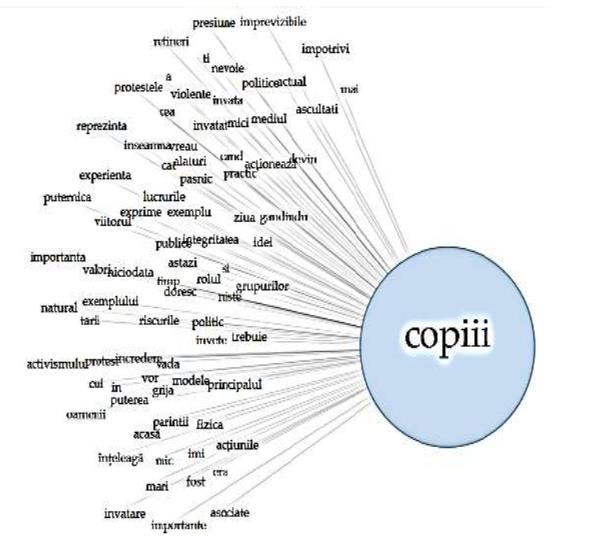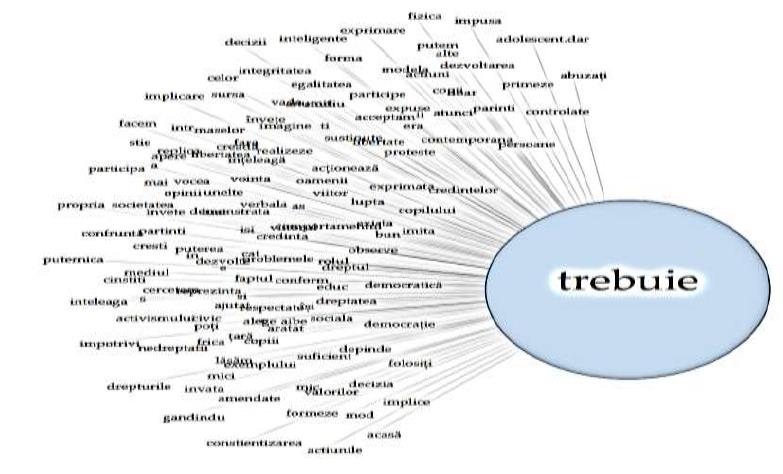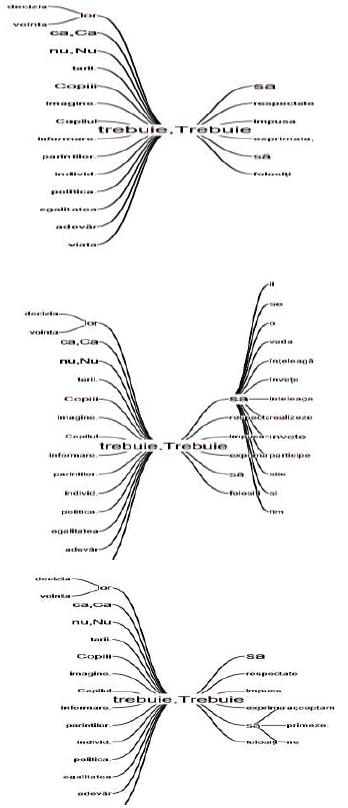Abstract
Romanian children’s participation in protests and marches held in February 2017, in all Romanian big
Keywords: Protestchildrenparticipationvaluescivic education
Introduction
The concept of political culture was firstly brought to attention by Almond and Powell (1966) who
considered that political culture of a society "consists of attitudes, beliefs, values, and skills which are
current in an entire population, as well as those special propensities and patterns which may be found within
separate parts of that population" (p. 23). Also we will consider political culture to imply an active or a
passive form of knowledge, emotions and values related to political subjects and to events that are
happening in a particular society. Dogan and Pelassy (1993) consider that the concept of political culture
"designates a set of political beliefs, feelings, and values that prevail for a nation at a certain time" (p.71).
One of the first modern studies that analyse the topic of political culture in democracy belongs to Almond
and Verba (1963) Civic Culture, Political Attitudes and Democracy in Five Nations, (p.13) that defines
political culture as political orientations or attitudes towards the political system. These authors have
generally asserted that political culture has broad implications that affect the performance of the political
systems (Almond & Verba, 1963, p. 31-34).
As a free public manifestation of ideas, opinions, beliefs and values, the protest is considered one of
the indicators of modern democracies. It is a specific manifestation of political culture and it is an active
way for citizens to get involved in the country's governing act. Turner (1969) considers that "An act of
protest includes the following elements: the action that expresses a grievance, a conviction of wrong or
injustice; the protestors are unable to correct the condition directly by their own efforts; the action is
intended to draw attention to the grievances; the action is further meant to provoke ameliorative steps by
some target group; and the protestors depend upon some combination of sympathy and fear to move the
target group in their behalf" (p.816). Opp (2009), considers that a protest is: "1. an action or a behaviour as
a joint action; 2. the actors object to one or more decisions of a target, so the actors have at least one
common goal; 3. the actors are unable to achieve their goals by their own efforts, instead, they put pressure on targets; 4. the behaviour is not regular, it is «unconventional». An action may be «unconventional» if
there are no institutional rules prescribing that it is repeated over time" (p.34).
Related to political culture and protest, it is also the concept of political socialization process. In his
study, Greenberg (2009) defines political socialization as the procedure through which people accept the
convictions and the principles of the political system they belong to and that determines their personal roles.
This definition is built on the premise that political socialization is the learning "process by which the
individual acquires attitudes, beliefs and values relating to the political system of which he is a member and
to his own role as a citizen within that political system" (p.3). Models mediated by different agents such as
family, school, institutions and organizations, media, the entire society as a whole, are mentioned in many
studies on this topic (Easton & Dennis, 1969; Kawata, 1986; Ross, 1984; Bragaw ,1989; Shaheen, 1989;
Allen, 1989). In the
socialization as "any political, formal and informal, deliberate and unplanned learning process at any stage
of the life cycle, including not only the explicit political learning but also the non-political symbolic
learning" (p.55). This definition emphasizes that socialization is a progressive learning process in a
continuous change. It is also worth mentioning that the definition includes references to both formal
education (school) and informal elements such as media, the influence of the social group, institutions, the
politic regime and all the others social factors.
Problem Statement
In the present context, not only for Romania, but also at a worldwide level, the novelty of children
participating in public manifestation is indisputable. Thus, the presence of children participating in protests
raises a series of questions for educators, psychologists, educational and social scientists about the
suitability of their participation in civic events and about the impact it has on children’s education. This research is focused on revealing the parents’ intentions that can be identified in the children`s presence in
protests.
Research Questions
What particular social values are parents trying to promote through their children’s involvement in
protests? Our aim is to identify which specific categories related to the axiological field can be recognised
in the parents' discourse (cognitive, behavioural, attitude-evaluative, affective dimension). Thus, we intend to describe, based on the content analysis of written material, the parents’ attitudes and perceptions
regarding the values promoted through the children’s participation in protests.
Purpose of the Study
Our aim is to explore the perceptions of socially active parents regarding the values promoted
through the participation of children in protests, using as main source of information the family, who is the
main decision-maker and the one that supports their involvement in this activity. For this, we will use the
next working definition of values: "Values are explicit or implicit conceptions of what is desirable. They
are not directly observable, but involve cognitive, evaluative and emotional elements, are relatively stable
over time, they generate behaviours and attitudes, determine and are determined by other values, and the
characteristics of the social environment" (Voicu, 2010, p.261).
The variable is the value described by the following categories:
1. cognitive dimension: knowing, understanding, learning; 2. behavioural-active dimension: to
participate, to act, to make, to defend, to express, to take part; 3. attitudinal dimension: acting, believing,
sustaining; 4. affective dimension: not be afraid, to be happy, to be proud; 5. evaluative dimension: honesty
(not to steal), dignity, social justice.
This categorization also corresponds to the theoretical approach of Almond and Verba (1963) which
underlines the idea that political culture is synonymous with the frequency of the following types of
guidelines: 1. "cognitive orientation", that is, knowledge of and belief about the political system, its roles
and the incumbents of these roles, its inputs and its outputs; 2. "affective orientation" or feelings about the
political system, its roles, personnel and performance; 3. "evaluational orientation", the judgments and
opinions about political objects that typically involve the combination of value standards criteria with
information and feelings (p.15).
Research Methods
the members of on-line community.
by 80 respondents between April 30th 2017 and July 20th 2017. Among the questions related to the topic of
children’s participation in protests, we have chosen the answers to three open questions: 1.
child/children in protest? 66 answers; 2.
important for children to participate in protests, along with their parents? 60 answers; 3.
him/her/they in protests/marches that you have participated in? 59 answers.
considering the aim of the present study and the topic of our research. The answers were aggregated in a
text of 2680 words that was considered to be the unit of analysis. In the process of coding we considered
the "value" the main concept that was associated with 5 categories, described by verbal indicators. Thus,
the coding unit, or the word, in going to be our main instrument for the present analyse.
parents’ answers to the three open questions. Voyant Tools is an open-source, web-based application for
performing text analysis, such as word frequency lists, frequency distribution plots, and KWIC displays.
Findings
A brief analysis of the presence, the frequency and the distribution of the concepts in the aggregated text
applying LIWC program reveals the following features: (Table
1.LIWC ResultsDate/Time: 7 August 2018, 10:44 am, the text you submitted was 2680 words in
length.
According to the methodological theory, "The word frequency usually indicates the important
themes of the text" (Agabrian, 2006, p.23). Taking into consideration this criterion, the important themes
of the text are: children*(58), involve*(33), participate*(31). However, although the word "fear"(7), does
not indicate a high frequency in the basic text, the code is very important for the entire study at the level of
the affective dimension indicators, which justifies our decision to consider it as a significant word in the
emotional semantic category.
As for the frequency of the different indicators, the text analysis using the Voyant Tool Program
highlights, with the exception of the link words, that the word must*(30) has the highest frequency and a
relatively constant distribution along the text.(Figure

In terms of absolute frequency, at the level of different dimensions that contain the values
emphasized by the parents in their discourse, we can hierarchize them by the criterion of importance:
1.
"to express", "to take part" related with codes like: participate* (31), action*(13) supportive*(3),
defend*(5), conduct*(2) - total 63 indicators
2.
upheld*(10), responsible*(8), believe*(1), attitude*(1), civic*(15) - total 53 items
3.
sample*(13), value*(1), truth*(1), lie*(1), community*(11) - total 36 items
4.
learn*(10), know*(6), idea*(7), understand*(1) - total 24 units
5.
emotions*(1), feeling*(1), trust*(2) - total 11 items
Thus, we can state that the attention of the respondents focuses on sending messages that predominantly
reveal the behavioural-active dimension. The adults are urging for action, for involvement, for participation,
but they are also discussing subjects such as the values promoted and that are in accordance with the model
provided by themselves. For this interpretation there is a limit, such as the existence of indicators that could
be part of at least two dimensions: the word "protest", for example, was not included in the encoding list,
to avoid ambiguity. The word "protest" (Figure

The relational or semantic analysis based on conceptual links, examines the relationships between
concepts. In order to accomplish the proximity analysis, which is focused on the concomitant occurrence
of explicit concepts in the text, we will associate the codes two by two just to highlight the links between
the codes. We will determine a sequence of words of given length, by looking at the links between the units
of measurement and by identifying the simultaneous presence of explicit concepts in the text. The proximity
criterion that we applied over the text would have verified the concomitant presence of the concepts, thus
creating the conceptual matrix of the unit analysis (Agabrian, 2006, p.101). Frequent associations of words
in the text have led to the identification of the following proximity (words together): "a child must"(30 times), "children’s future"(13 times), "children's education"(13 times), "children’s participation"(8 times),
"children in protests" (8 times), "civic education"(7 times), "civic responsibility"(7 times), "the source of
learning"(7 times), "active implication matters"(7 times), "politic environment"(6 times), "participation in
protests" (6 times), "to promote values" (5 times), "community`s life"(5 times), "to involve children"(5
times), "the future society"(5 times), "it is a must to participate"(5 times), "the power of the example"(4
times), "the right to express"(4 times), "the participatory democracy"(3 times). Thus, the formed matrixes
or the interrelated contextual groups of concepts which suggest the parental concern for mainly cultivating
behavioural-active aspects and civic values as well as their will to be part of the community`s
life. Comparison of semantic links in text: 1. Analysis for the key concepts:


2.Analysis of relations between the most frequent concepts:

1. behavioural-active dimension,
There are also two significant relationships between the codes children* and participate* (Figure
which highlight the intensity of the connection mediated by the words of the link, making a statement (two
concepts and the relations between them).

2.
structure of the two actors involved, the link between the children who learn and the parents who transmit
messages.
We also identify relational indicators belonging to the active-behavioural sphere, "involvement”, “expression”, “intervention”, “solving”, “protests”, “information”, “protect'' but also some of them related
to the evaluative sphere: ''good”, “values”, “community”, “the others”, “power”, “secure”, “independent”,
“political, “free". In other words, the content of learning mainly refers to behaviours, but also to appreciative
and evaluative aspects. This relationship reveals that learning refers both to active and behavioural practice
regarding the good example of parents and significant adults around.

1.
fearful of saying”, “not being afraid to express yourself”.

The concept maps are tools for organizing and representing the information in the text unit. The
concept map, as a graphical representation of the relations between concepts, aims to indicate the direction
of the relationship between them, trying to create a model of the general meaning of the concept of value,
which can offer the possibility to analyse them through comparison. There are two significant relationships
involving the codes protest* and must*, which highlights the intensity of the relationship mediated by the
link words, making a statement.

The word "must" has been identified in the context of analysis as having the highest frequency
among all the indicators, which has led us to deepen the analysis of its link with other concepts. Thus, by
realizing the map-concept (Figure
connection with decision and will (volitional and active dimension), but also with elements belonging to the cognitive sphere such as “to learn”, “to understand”, “to see”, as well as with verbs like “to accomplish”,
“to participate”, “to accept”, “to prevail”.
Conclusion
Considering concepts in the form of "ideative nuclei" (Agabrian, 2006, p.99), identified in the
respondents' answers to the three open questions in the online survey, we will consider that the ideological
nuclei of the messages that parents want to convey to their children have a pronounced behavioural-action
and an attitudinal predominance. Adults want to convince their children that there is a need (imperative
"must") for involvement and participation, by following their example, with reference to the evaluative
dimension. Another key concept that is related to the first one is the indicator civic* which defines the
attitude of the public protests and manifestations, although it is more recognized at the implicit level in the
answers received and less explicitly in the written messages and in the messages displayed in public space
on banners. Regarding the evaluative dimension, frequent reports are verbal testimonies such as "not to steal", "not to lie’’, placed in contrast to what is desirable. For children the message sent is the will to avoid
doing what is not in accordance with the generally accepted civic and moral values.
Although there were found in the parents' answers to the questionnaire, both references to cognitive and
affective dimensions are at a secondary level related to the attitudinal and behavioural - active elements
promoted. The emotional aspects invoked are “
mentioned in the analysis unit 3 times. What has been specifically and somewhat atypically has been the
invocation of fear, denial, "not to be afraid," that refers to history, functioning as an intention to demolish,
to defeat some fears of the past.
References
- Agabrian, M. (2006). Analiza de conținut. [Content analysis] Iași, Editura Polirom.
- Allen, J. (1989). Research in Review: children’s political knowledge and attitudes. Young Children, 44, pp. 57-61.
- Almond, G.&Verba, S. (1963). Civic Culture. Political Attitudes and Democracy in Five Nations. Princeton: Legacy Library.
- Almond, G.& Powell, Jr. G. (1966). Comparative Politics: A Developmental Approach. Boston: Little, Brown and Company.
- Bragaw D. (1989.) In Training to be a Citizen: the elementary student and the public interest, Social Science Record, 26, pp. 27-29.
- Dogan, M.& Pelassy D. (1993). Cum să comparăm națiunile, [How to compare nations]. București: Ed. Alternative.
- Easton, D.& Dennis, J. (1969). Children in the Political System. Origins of Political Legitimacy. New York: McGraw-Hill.
- Greenberg, E. (2009). Political Socialization. New York: Lieber-Atherton.
- Greenstein, Fred I. (1968). „Political Socialization”. In Sills D., Merton R., International Encyclopedia of Social Sciences, vol. 14, New York, Macmillan Publishers Company.
- Kawata, J. (1986). The Child’s Discovery and Development of ‘Political World’: a note on the United
- States, Konan Law Review, 21, pp. 233-265.
- Opp, K.-D. (2009). Theories of Political Protest and Social Movements:A Multidisciplinary Introduction,
- Critique, and Synthesis.New York, Londra: Routledge.
- Shaheen, J. (1989). Participatory Citizenship in the Elementary Grades. Social Education,53, pp.361-363. Ross, A. (1984). Developing Political Concepts and Skills in the Primary School. Educational Review, 36, pp. 131-139.
- Turner, R.H. (1969). The Public Perception of Protest. American Sociological Review, 34(6).
- Voicu, B. (2010). Valorile și sociologia valorilor. [Values and sociology of values] in Vlăsceanu L.(coord.),
- Sociologie, [Sociology] Iași, Polirom.
- Stiri.ONG. (2017). Copiii și democrația. Ce cred părinții activi social? Chestionar. [Children and
- democracy. What do socially active parents think? Questionnaire] Retrieved from
- https://www.stiri.ong/ong/civic-si-campanii/copiii-si-democratia-ce-cred-parintii-activi-social
- chestionar.
Copyright information

This work is licensed under a Creative Commons Attribution-NonCommercial-NoDerivatives 4.0 International License.
About this article
Publication Date
15 August 2019
Article Doi
eBook ISBN
978-1-80296-066-2
Publisher
Future Academy
Volume
67
Print ISBN (optional)
-
Edition Number
1st Edition
Pages
1-2235
Subjects
Educational strategies,teacher education, educational policy, organization of education, management of education, teacher training
Cite this article as:
Popa*, L. (2019). Children, Media And Democracy. Romanian Children Participating In Protests. In E. Soare, & C. Langa (Eds.), Education Facing Contemporary World Issues, vol 67. European Proceedings of Social and Behavioural Sciences (pp. 1543-1554). Future Academy. https://doi.org/10.15405/epsbs.2019.08.03.189
